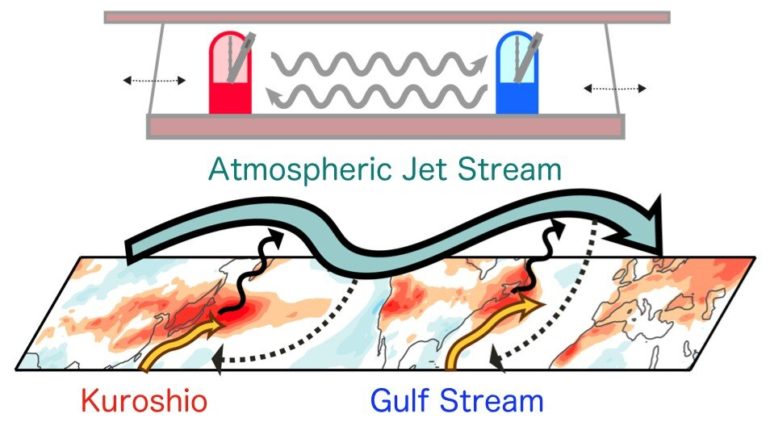A team of researchers with members affiliated with a large number of institutions across Japan has found that the Gulf stream and Kuroshio are synchronized on a decadal time scale. In their paper published in the journal Science, the group describes their study of decades of weather satellite data and the link between the two ocean currents. Paola Cessi, with the Scripps Institution of Oceanography at the University of California, has published a Perspective piece on the work done by the team in Japan in the same journal issue.
The Gulf Stream is an ocean current that begins in the Gulf of Mexico and extends past the southern tip of Florida. It then follows the eastern U.S coastline before colliding with currents in the North Atlantic Ocean. Kuroshio is a similar type of current that flows from south of Japan in the East China Sea until it collides with Oyashio, a more northerly current. Prior research has shown that both heavily influence weather conditions in the northern hemisphere; for example, large storms typically arise at the points where they meet colder currents. In this new effort, the researchers have found that the two currents are synchronized over a decadal time scale.
To learn more about a possible connection between the two currents, the researchers collected and studied a massive amount of weather data and created models to show how the two systems might impact one another.
They found that the westerly jets carried energy from the two currents all the way around the globe. As heat from Kuroshio was carried into the atmosphere, for example, where it met Oyashio, storms were generated that moved from west to east—all the way across the northern parts of the Pacific Ocean. The Jet Stream then carried that energy across the continental U.S. and all the way to the Atlantic. There, it collided with heat carried into the atmosphere by the Gulf stream as it collided with the Labrador Current. The vast distances involved meant it took a long time for energy from one of the currents to have an impact on the other. But the end result was some degree of synchronization of the two currents, a finding that could improve weather forecasting in the northern hemisphere in the future.
Florida current is weaker now than at any point in the past century
More information:
Tsubasa Kohyama et al, The Gulf Stream and Kuroshio Current are synchronized, Science (2021). DOI: 10.1126/science.abh3295
Paola Cessi, Gulf Stream and Kuroshio synchronization, Science (2021). DOI: 10.1126/science.abl9133
2021 Science X Network
Citation:
Gulf Stream and Kuroshio Current found to be synchronized on decadal time scale (2021, October 15)
retrieved 17 October 2021
from https://phys.org/news/2021-10-gulf-stream-kuroshio-current-synchronized.html
This document is subject to copyright. Apart from any fair dealing for the purpose of private study or research, no
part may be reproduced without the written permission. The content is provided for information purposes only.



